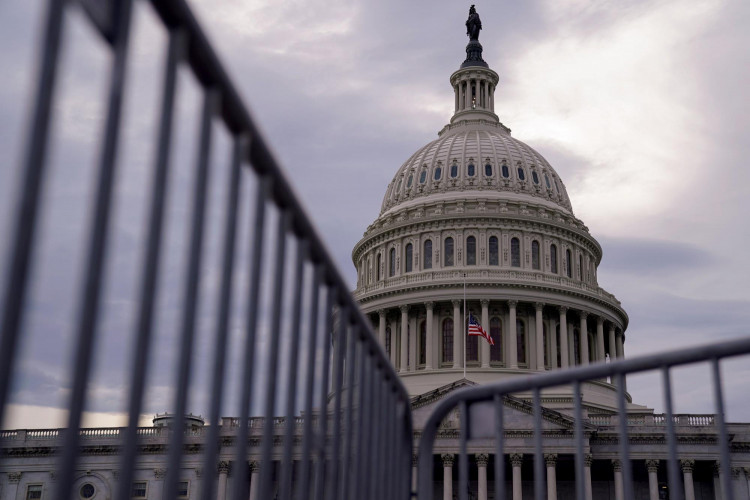Ever since the Republican Party seized control of the House of Representatives in last year's midterm elections, a primary goal has been to force the Biden administration to cut spending.
Earlier this year, as the U.S. government faced the risk of a debt default, one of the GOP's negotiation terms with the Biden administration was a significant reduction in the 2024 fiscal year budget. Hardline conservatives within the party demanded discretionary spending be cut to $1.47 trillion, equivalent to the 2022 fiscal year level. However, the eventual agreement reached between House Speaker Kevin McCarthy, a Republican, and Biden was $1.59 trillion.
This agreement was met with strong disapproval from the GOP's conservative faction, accusing McCarthy of being weak. As the federal government approaches the start of a new fiscal year in October, and Congress needs to pass a spending bill for that year, these conservatives are seizing the opportunity to overturn the agreement McCarthy made with Biden.
Over the past week, infighting among House Republicans regarding the new fiscal year's spending bill has intensified, with some members calling for McCarthy's removal. McCarthy's election as Speaker was initially met with skepticism from the party's conservative wing, and it took 15 rounds of voting for him to secure the position.
If Congress doesn't pass a spending bill by midnight on September 30, the government will face a shutdown starting October 1. Since 1976, there have been 20 federal government shutdowns. Some analysts predict this potential shutdown could rank among the longest.
GOP Turmoil
Of the 12 appropriation bills Congress needs to pass by September 30, only one has been approved by the House as of September 20, covering veterans' affairs and military construction. The Senate, led by Democrats, hasn't passed any.
On Wednesday, the White House released a lengthy statement condemning the "extreme Republicans in the House," accusing them of recklessly pushing radical demands. If these demands aren't met, Republicans are prepared to force a government shutdown, affecting everyday Americans.
Republicans, on the other hand, blame the Democratic administration for trying to pin the potential shutdown on them. McCarthy urged unity among House Republicans, warning that a government shutdown would only benefit the Democrats.
During negotiations with conservative Republicans on Wednesday evening, McCarthy proposed a new plan.
The new proposal suggests the House first approve a temporary spending bill to sustain a month's expenditure, temporarily capping the federal government's discretionary budget for the new fiscal year at the $1.47 trillion level demanded by the hardliners. The plan also includes stricter immigration controls and establishes a special committee to track federal spending and debt.
According to McCarthy's plan, after implementing the temporary spending bill and avoiding a government shutdown, the House would introduce another spending bill, capping the federal government's budget at $1.56 trillion for the new fiscal year. This amount is still below the $1.59 trillion previously agreed upon between McCarthy and Biden.
In an interview with U.S. media on Wednesday evening, McCarthy expressed confidence in the new plan, saying, "I believe we have a plan to move forward." It remains unclear whether McCarthy's new proposal will gain approval from the hardliners. House Republicans have been notified to be prepared for potential weekend voting.
Last week, the GOP's conservative faction repeatedly rejected McCarthy's proposals, insisting on capping the new fiscal year's budget at $1.47 trillion. Some members openly criticized McCarthy for being weak, with others threatening to oust him.
Even if McCarthy's new proposal gains approval from House Republicans, due to the significantly lower budget amount than the agreement between Biden and McCarthy, and additional conditions like stricter immigration controls, the Democratic-led Senate is likely to reject or modify the proposal, sending it back to the House. McCarthy's new proposal also omits the $20.6 billion in new aid to Ukraine that Biden requested from Congress.
Given the refusal of the GOP's hardliners to compromise, McCarthy's challenge is to produce a proposal within 10 days that gains approval from both the House and Senate, implying he might need to collaborate with Democrats.
Currently, Republicans hold 221 seats in the House, while Democrats have 212. However, if McCarthy extends an olive branch to the Democrats, the GOP's conservative faction will likely take action to remove him from his Speaker position.
To break the current deadlock, moderate House Republicans and Democrats have begun discussing passing the spending bill in a bipartisan manner. Whether this plan can be implemented before September 30 remains uncertain.
Another Shutdown on the Horizon?
If the U.S. Congress doesn't reach an agreement on the spending bill, starting October 1, the federal government will shut down all non-essential services. National parks, museums, and passport services will be closed or partially closed.
Some government employees will be forced into unpaid leave, while most essential position workers will work without pay. Postal services, Social Security, and Medicare will continue to operate. Although a federal shutdown primarily affects federal employees, depending on its duration, it can also have a domino effect.
The last U.S. federal government shutdown occurred in December 2018 during the Trump administration, lasting 35 days, making it the longest government shutdown in U.S. history.
Due to being required to work without pay, many government employees began taking sick leave. By the end of January 2019, staff shortages at the Transportation Security Administration led to long lines at airports nationwide.
The Congressional Budget Office estimated that the federal government shutdown from late 2018 to early 2019 resulted in a permanent loss of $3 billion to the U.S. economy.
Investment firm AGF Investments predicts a 70% chance of a U.S. federal government shutdown in October, which, in the worst-case scenario, could last until winter. Bond giant PIMCO's head of public policy, Libby Cantrill, also believes that if the federal government shuts down in October, it will last a long time.
Cantrill stated that the complex situation among House Republicans means there's a lack of a "catalyst" to reopen the government. She also noted that a federal government shutdown would prevent timely collection and release of key market data such as GDP, unemployment rate, and inflation rate, affecting the Federal Reserve's ability to assess the U.S. economy and potentially impacting the Fed's November policy meeting.
Goldman Sachs' assessment suggests that the impact of a federal government shutdown on the U.S. economy is limited.
The assessment points out that, unlike the debt ceiling issue, a government shutdown is more manageable from a macroeconomic perspective. After a shutdown, since most government department work is deemed essential, about 65% of federal employees will continue to work. Market investments and purchases of goods and services remain unaffected.
Historical data shows that the market's reaction to federal government shutdowns is not strong. The assessment indicates that during the three prolonged shutdowns since 1990, the U.S. stock market showed no significant changes, even experiencing some ups and downs. After a government shutdown, the dollar slightly weakens, and the 10-year Treasury yield generally declines.
The assessment also warns that precisely because the impact of a federal government shutdown on the economy is less severe than a debt ceiling standoff, there's a greater likelihood that the U.S. Congress will delay taking action.






